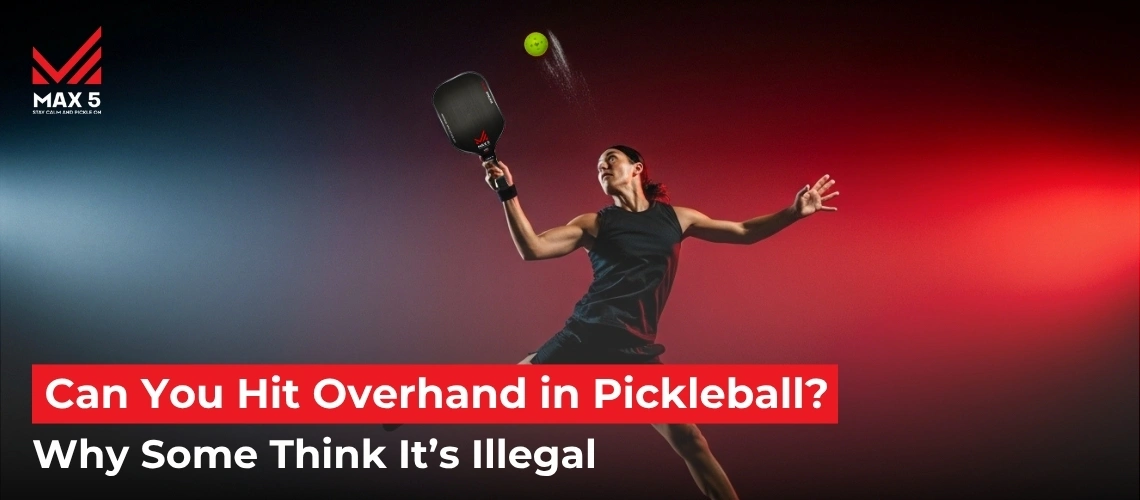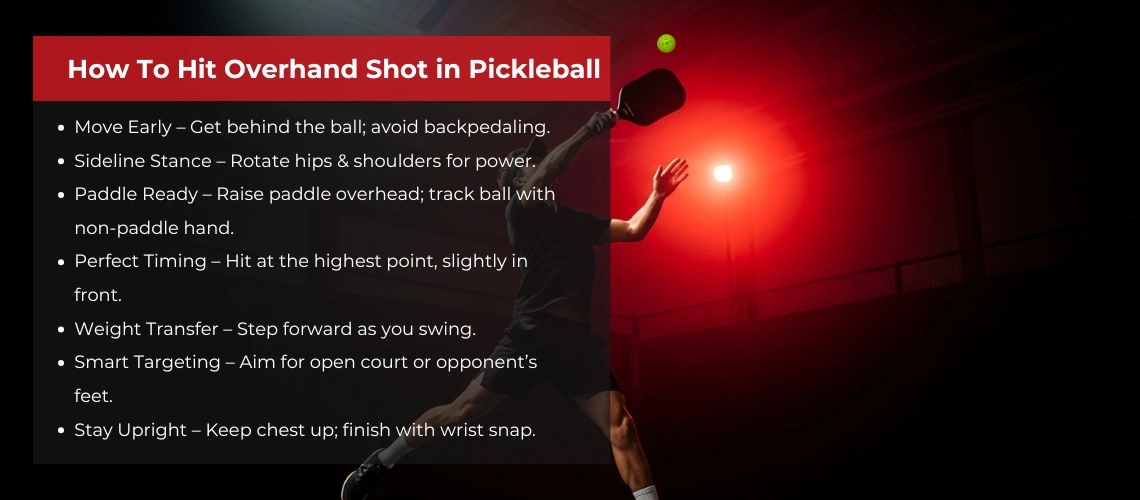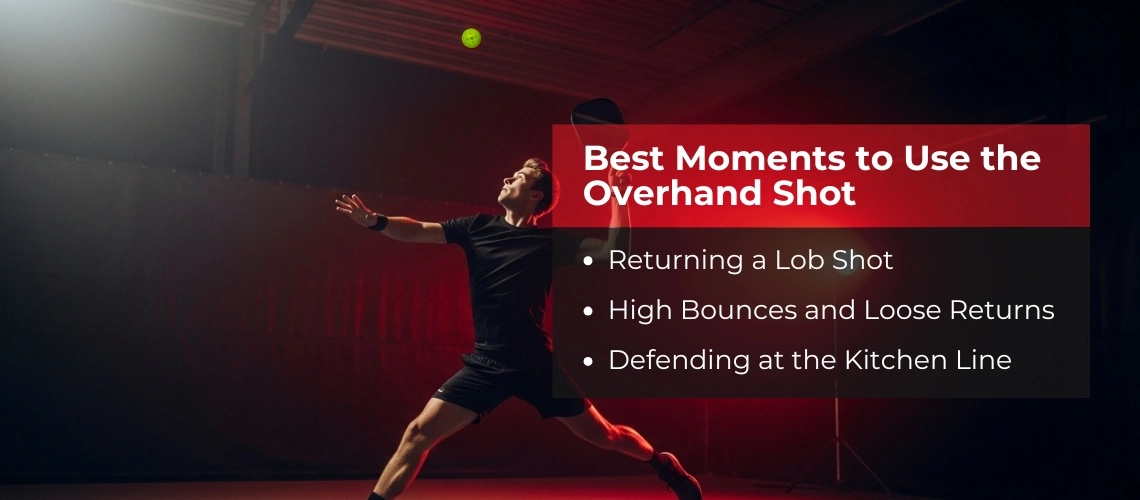
Can You Hit Overhand in Pickleball? Why Some Think It’s Illegal
The adrenaline on that final pickleball shot? Always better with an overhand. Nothing feels sharper than slamming the ball down fast and clean, unless someone yells, “Illegal!” So, can you hit overhand in pickleball? Yes, but not on the serve, or the first two hits after it. Overhead shots are 100% legal during rallies and remain the go-to defense against high lobs.
This guide clears up confusion and explains when overhands are legal, what makes them illegal, the 2025 serving rule updates, and new ways players are using overhead shots strategically. Whether you’re spiking or defending, we’ll break it all down.
What is Overhand Shot or Smash?
An overhand shot or overhead smash is a forceful, downward strike used to counter high lobs or weak returns. Many professional players who lean towards aggressive shots use it. It’s a momentum-shifting shot in pickleball when executed properly. Here’s how it works:
How To Hit Overhand Shot in Pickleball
Overhand shots in pickleball, commonly known as smashes, require more than just raw power (like in tennis). It comes with practicing body control, timing, and clean technique. Here’s how to set up and finish the shot properly:
- Move early: Get behind the ball before it drops. Don’t backpedal, pivot, or run to position.
- Stance matters: Rotate your shoulders and hips so they face the sideline. This creates leverage.
- Paddle prep: Raise your pickleball paddle above your head by extending your elbow. Use your non-paddle hand to track the ball.
- Timing: Make contact with the pickleball at the highest possible point. Make sure the ball is slightly in front of your body.
- Weight transfer: Shift your weight forward as you swing downward.
- Target smart: Aim for open court space or your opponent’s feet, not their body.
- Stay upright: Keep your eyes & chest up, don’t collapse into the swing. Hit hard and finish with a clean wrist snap.
Done right with a lightweight paddle, it’s your best weapon against weak lobs.
Can You Hit Overhand in Pickleball?
Yes, you can hit overhand in pickleball, but not in two situations. Overhand shots like smashes and spikes are completely legal once the rally is live. That said, pickleball overhand serves are not allowed under standard rules. See when and why:
When You Can’t Hit Overhand in Pickleball
Overhand shots are only illegal in two cases
- On the serve
- During the first two hits of a rally
Overhand Serves Are Not Legal in Pickleball
The most common misconception among players switching from tennis is this: “Can you serve overhand in pickleball?” The answer is no.
Legal Serve Requirements:
If your contact point is too high or your paddle angle is downward, the serve becomes illegal. That’s non-negotiable under USA Pickleball rules.
- Paddle must contact the ball below the navel
- Swing motion must move upward, not downward
- Paddle head must stay below the wrist
- A player must keep one foot behind the baseline.
- Ball must be hit before it bounces (unless doing a drop serve)
An exception!
Major League Pickleball introduced a controlled overhand serve format in 2024, but it’s restricted to MLP-specific play. It requires:
- A visible toss
- Upward swing (still enforced)
- Compliant paddle and wrist positioning
This doesn’t apply to rec games or tournaments governed by official USAPA rules. Stick to underhand or drop serves in regular play.
The 2-Bounce Rule Blocks Early Overhands
The 2nd and 3rd shots? No overheads because bounce rules apply. Even if you’re gifted a perfect lob on shot two or three, you can’t smash it out of the air. Why? The 2-bounce rule requires:
- The serve must bounce once
- The return must bounce again
- Only after that can volleys or overheads be played
Situations Where You Should Avoid Overhands (Even If Legal)
Understanding when not to hit overhand will keep you from losing. Here are tactical moments where an overhand shot just doesn’t work, even if it’s technically legal:
- When the ball comes in below waist height
- When you’re off-balance or out of position
- Near the non-volley zone, where follow-through might cause a fault
- During slow exchanges, where a hard overhead resets the rhythm (but not in your favor)
When Can You Hit Overhand in Pickleball?
Once both bounce requirements are met, you can hit overhand in pickleball without restriction. These shots are legal, encouraged, and often earn points. Here’s When Overhands Are Allowed:
- After the 2-bounce rule is complete (post-serve and return)
- During rallies, when the ball pops up or floats
- After a bounce, if the ball rises high enough
- On reaction volleys outside the non-volley zone
Common Legal Overhand Shot Types
- Overhead Volleys: Fast, direct strikes taken mid-rally are great for punishing weak pop-ups or misfired dinks.
- Smashes and Spikes: Use when your opponent floats a lob or slow shot. Time the contact at the peak and swing through with power and placement.
- Deep Overhand Lobs: Great for flipping the court when under pressure. Best used from the baseline or mid-court with control.
Note! Why You Can’t Serve Overhand in Pickleball
Many players coming from ping pong or tennis get shocked by the “underhand only” serve rule. But here’s the logic “pickleball was built for rallies, not one-shot winners”. That means:
- Long exchanges are prioritized over fast aces
- The serve is designed to start the point, not end it
- Age and skill don’t limit who joins the game.
Try Out these Overhand Shot Techniques!
You can apply overhand shots with variety and styles! Here’s how to develop, refine, and apply overhand shots like a professional pickleball player.
Overhead Smash Fundamentals
Pickleball players can hit an overhead smash in pickleball matches, and it can be a serious weapon. The overhead smash is your go-to attack when an opponent lobs the ball or floats a weak return. The motion is direct and aggressive, high contact point, full extension, and a fast downward strike.
How to do it:
- Track the lob early and shuffle back without crossing feet.
- Turn sideways with your hitting arm pulled back like a throwing motion.
- As the ball drops into your strike zone, explode with a wrist snap and paddle follow-through down into the court.
- Target the middle in doubles, or corners in singles if your angle allows.
Key Tip! Don’t backpedal. Always pivot and move with balance to reduce injury and set up the shot. Overhead smashes often push players forward, and that’s where foot faults happen. The Non-Volley Zone line is off-limits during any volley, including overheads. While practicing, end your overhead smash with your weight balanced slightly back to stay behind the NVZ safely.
Jump Smash for Lob Returns
Jumping into an overhead smash isn’t required, but it’s an advanced tool when you’re trying to reach a deep lob or generate a sharper angle.
- Who is it for? Shorter players looking to overcome reach disadvantage, or those with a background in volleyball or basketball.
Execution tips:
- Watch the lob’s arc and decide if a jump puts you in control.
- Push off both feet, strike at peak height with full extension, and land in control.
- Use your off-hand to stabilize and trace the shot.
Reality check! This is high-risk. If you’re still learning footwork or timing, prioritize grounded smashes.
Spike Shot Technique
A spike in pickleball is a power-focused overhand shot, usually delivered near the kitchen line when the opponent floats a high return.
Key mechanics:
- Keep paddle face square and drive the ball down using shoulder and wrist.
- Strike flat if aiming to overpower, or slice across the ball for added spin.
- Always aim for feet, mid-body gaps, or sideline angles—not directly at paddle-ready zones.
When to use it:
- High bounce after a weak dink.
- Defensive lobs landing too short.
- Midcourt resets that pop up high.
The High Ball Rule
You can legally hit an overhand inside the Non-Volley Zone only after the ball bounces. Many players break this without realizing it. Understand that:
- Standing in the kitchen? Don’t try an overhand volley, it’s an automatic fault.
- Outside the NVZ? You’re free to smash overhead.
Best practice: Train your instincts to identify ball height vs. position. This minimizes rule violations and shot hesitation.
Best Moments to Use the Overhand Shot
Knowing when to attack overhead is half the game. These scenarios demand well-executed overhands:
1. Returning a Lob Shot
Lobs push you back, but they’re also invitations to strike. The moment your opponent sends one high and slow:
- Turn and shuffle to reposition.
- Keep eyes on the ball, hand pointed up for tracking.
- Get feet planted and hit the ball at its highest peak for control and power.
A properly timed overhand shot here stops momentum shifts and resets court control.
2. High Bounces and Loose Returns
A soft & high return bouncing into your strike zone is your green light.
- Stay grounded and prepare early with a high paddle position.
- Drop the paddle forcefully down into the shot, targeting your opponent’s feet or empty space.
- Follow through completely. This isn’t a poke, it’ll be a finisher.
3. Defending at the Kitchen Line
If your opponent returns a weak dink or high volley:
- Step forward or sideways, not into the kitchen unless it bounces.
- Punch with a compact, overhand motion and keep the ball low and fast.
- Angled smashes here disrupt formation and apply pressure fast.
For a deeper understanding and practical tips, check out this helpful guide from USA Pickleball—it’s a great resource to improve your game.
Mastering the Pickleball Serve
In tennis serve is about brute force; however, in pickleball, it’s more about precision. Here’s how to serve effectively without fault in pickleball:
- Start by building a consistent foundation.
- Use visual markers to regulate serve height, record yourself to review form
- Begin with basic serves before mixing in spin or angle changes.
Your equipment matters too. Paddles with textured surfaces or elongated handles can fine-tune your spin and reach. Looking for tournament-quality bounce and visibility? The Max 5 Vintage MX-0.1 Carbon Pickleball Paddle & PRO Pickleballs 3 or 6 Pack delivers both.
Final Take: Can You Hit Overhand in Pickleball?
Yes, you can hit overhand in pickleball, but only in legal situations like returning a lob or outside the non-volley zone. Understanding how, when, and why to use an overhand shot keeps your play clean and competitive. Buy durable USAPA-approved pickleball paddles and balls to practice daily!
Frequently Asked Questions
Do you always have to hit underhand in pickleball?
No. Only serves must be underhand. During rallies, you’re free to hit overhand, especially on high returns. Overhand shots like smashes and spikes are completely legal outside the kitchen.
Is it a fault when I play an overhand shot?
Overhand shots are legal after the serve and bounce phases. The only fault occurs if you serve overhand, which breaks pickleball’s rule requiring underhand serves below the waist.
What are the best grips for overhand hits?
The continental grip works best for overhand shots, especially smashes. It balances control and power. Rotate to a strong continental grip for added force on aggressive lobs or overhead returns.
What are common mistakes to avoid when serving in pickleball?
Many faults occur when players serve incorrectly. Common errors include contacting the ball above the waist, using a side swing, stepping on the baseline, mishandling drop serves, or letting the wrist angle break during contact.
How can I practice overhand shots alone in pickleball?
Toss and smash balls to court targets, use wall drills, or lob to yourself. Focus on clean footwork, contact height, and consistent paddle control.
What are good partner drills for overhead smashes?
Try crosscourt volleys with lobs, rotate feeder-finisher roles, and add overheads into live rallies. These drills build timing, pressure handling, and better finishing accuracy under game conditions.


